Yes. I have seen in the photo gallery of the battalion and recall in the written history that they were able to scavenge German 88's and other pieces that the Germans may have captured and utilized in their earlier successes in Poland, Russia, Belgium, Holland and France. I will take enough time to reread the written history of the unit published immediately at the end of the war and provide more detail.Clarification - these were captured German field pieces and ammo? Ironic, since that was what Hitler was trying to accomplish with his counterattacks...
75th anniversary of D-Day...
- Thread starter crimsonaudio
- Start date
- Status
- Not open for further replies.
August 12, 1944: Southwest of Falaise, the US 3rd Army’s XV Corps moves to the north, facing numerous skirmishes with the SS Panzer divisions. The French 2nd Armored Division now controls the town of Alençon, after heavy fighting in the streets yesterday. The French then enter Ecouché on the road to Argentan. The XV Corps manages to reach the same region near Argentan by the end of the day: the American 1st and 3rd armies have now pushed the German forces back over 30 miles in a week. The American front, which was oriented from north to south on August 5th, is now oriented east to west. Further north, the British 2nd Army and Canadian 1st Army advance southward: the Germans are trapped between the two fronts and there is only one way out - retreating towards Falaise.
The American, British and Canadian troops are now facing each other, which poses potential problems for the allied officers: while the Germans are surrounded (and being heavily bombarded by Allied artillery and air force), the two fronts are getting closer, and in such a situation the Allies may hit each other. General Patton, commanding the 3rd Army, requests permission from General Bradley to close the pocket and to join the Canadians at Falaise, but Bradley is worried about the risks of friendly fire and he asks Patton to remain at the latitude of Argentan, securing the are surrounding the town. This angers Patton: closing the Falaise pocket immediately would mean the end of the German Army in Normandy. But US command stands firm and orders Patton to stop his progress for a few hours - hours that will benefit the thousands of German soldiers, allowing them to reach the Seine river.
The first PLUTO (Pipe Line Under The Ocean) becomes operational carrying fuel from the Isle of Wight to Cherbourg.
Over France, RAF Bomber Command sends 117 aircraft to attack oil facilities at Foret de Montrichard and 70 aircraft to attack U-boat pens at Brest, Bordeaux, and La Pallice during the day. US 8th Air Force attacks targets around Paris with 500 bombers and attacks transportation lines throughout northeastern France with 900 fighters. US 9th Air Force attacks targets around Argentan. As part of Operation Frantic, 72 US 8th Air Force bombers flying from Italy, after previously returning from bases in the Soviet Union, attack Toulouse and continue onward to the UK. Overnight, RAF Bomber Command sends 144 aircraft to attack German troop positions around Falaise and 52 aircraft to attack V-weapons sites.
Over Germany, RAF Bomber Command sends 379 aircraft to attack Brunswick, 297 aircraft to attack Russelsheim, and 12 aircraft to attack Kiel overnight.
The first transport of civilians arrested in Warsaw, Poland after the start of Warsaw Uprising reach Auschwitz II-Birkenau concentration camp via Pruszków transit camp. 1,984 males and over 3,800 females are in this transport.
In Italy, elements of US 5th Army complete the capture of Florence. US 12th Air Force aircraft attack targets along the Arno River and US 15th Air Force attacks Genoa and Savona with 307 bombers.
Pictured: A map of the formation of the Falaise Pocket; German prisoners taken during the battle are given tea by their captors, August 12, 1944; Lance-Corporal Don Fife on a motorcycle en route to Falaise, August 12, 1944; Sherman tanks of the 4th Canadian DB gather as parts of operation Tractable, taken west of Estrées-la-Campagne, August 12, 1944
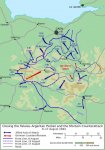
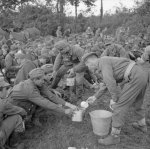
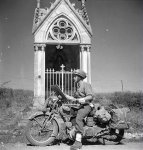
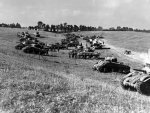
The American, British and Canadian troops are now facing each other, which poses potential problems for the allied officers: while the Germans are surrounded (and being heavily bombarded by Allied artillery and air force), the two fronts are getting closer, and in such a situation the Allies may hit each other. General Patton, commanding the 3rd Army, requests permission from General Bradley to close the pocket and to join the Canadians at Falaise, but Bradley is worried about the risks of friendly fire and he asks Patton to remain at the latitude of Argentan, securing the are surrounding the town. This angers Patton: closing the Falaise pocket immediately would mean the end of the German Army in Normandy. But US command stands firm and orders Patton to stop his progress for a few hours - hours that will benefit the thousands of German soldiers, allowing them to reach the Seine river.
The first PLUTO (Pipe Line Under The Ocean) becomes operational carrying fuel from the Isle of Wight to Cherbourg.
Over France, RAF Bomber Command sends 117 aircraft to attack oil facilities at Foret de Montrichard and 70 aircraft to attack U-boat pens at Brest, Bordeaux, and La Pallice during the day. US 8th Air Force attacks targets around Paris with 500 bombers and attacks transportation lines throughout northeastern France with 900 fighters. US 9th Air Force attacks targets around Argentan. As part of Operation Frantic, 72 US 8th Air Force bombers flying from Italy, after previously returning from bases in the Soviet Union, attack Toulouse and continue onward to the UK. Overnight, RAF Bomber Command sends 144 aircraft to attack German troop positions around Falaise and 52 aircraft to attack V-weapons sites.
Over Germany, RAF Bomber Command sends 379 aircraft to attack Brunswick, 297 aircraft to attack Russelsheim, and 12 aircraft to attack Kiel overnight.
The first transport of civilians arrested in Warsaw, Poland after the start of Warsaw Uprising reach Auschwitz II-Birkenau concentration camp via Pruszków transit camp. 1,984 males and over 3,800 females are in this transport.
In Italy, elements of US 5th Army complete the capture of Florence. US 12th Air Force aircraft attack targets along the Arno River and US 15th Air Force attacks Genoa and Savona with 307 bombers.
Pictured: A map of the formation of the Falaise Pocket; German prisoners taken during the battle are given tea by their captors, August 12, 1944; Lance-Corporal Don Fife on a motorcycle en route to Falaise, August 12, 1944; Sherman tanks of the 4th Canadian DB gather as parts of operation Tractable, taken west of Estrées-la-Campagne, August 12, 1944




Interesting to see the Armored Vehicle Launched Bridge (AVLBs) in that photo.
An AVLB, for those unfamiliar with them, is a hydraulically-deployed bridge used to allow tanks to get across fairly small creeks and other gaps. Useful in terrain with numerous small creeks with steep sides or to get across an antitank ditch. I'm not sure which chassis these were mounted on, but the Brits used a Valentine tank chassis for their AVLBs and put a 10m Class 30 bridge on them. The Valentine was obsolete by 1944, since it lacked strong armor protection, but these were not going to fight, they just carried the bridge and tagged along at the rear of the column and bridged gaps when needed.
Last edited:
I was curious which German units were there to resist the 2ème Division Blindée. This site says elements of the 2nd and 9th Panzer Divisions. Alençon (Orne) The cities of Normandy during the 1944 battlesAugust 12, 1944: Southwest of Falaise, the US 3rd Army’s XV Corps moves to the north, facing numerous skirmishes with the SS Panzer divisions. The French 2nd Armored Division now controls the town of Alençon, after heavy fighting in the streets yesterday. The French then enter Ecouché on the road to Argentan.
Leclerc, while personally conducting reconnaissance before the battle, came across a German armored reconnaissance vehicle.
If it was 9th Panzer, then this was the unit from near Bordeaux, and it had been getting around. It had driven up from Bordeaux (600 km), taken part in the Mortain counteroffensive, and by 12 AUG 44 was in Alençon (90 km away from Mortain). You have to wonder what kind of shape the 9th Panzer was in by 12 AUG. These guys had been "rode hard and put up wet."
The link indicates the locals in Alençon were ecstatic to be liberated by Frenchmen.
Last edited:
I’m one of those that was unfamiliar with the AVLB. Here is a link to a video of a more modern AVLB which shows how it is set up and retrieved.Interesting to see the Armored Vehicle Launched Bridge (AVLBs) in that photo.
An AVLB, for those unfamiliar with them, is a hydraulically-deployed bridge used to allow tanks to get across fairly small creeks and other gaps. Useful in terrain with numerous small creeks with steep sides or to get across an antitank ditch. I'm not sure which chassis these were mounted on, but the Brits used a Valentine tank chassis for their AVLBs and put a 10m Class 30 bridge on them. The Valentine was obsolete by 1944, since it lacked strong armor protection, but these were not going to fight, they just carried the bridge and tagged along at the rear of the column and bridged gaps when needed.
[video]https://www.military.com/video/combat-vehicles/armored-vehicles/armored-vehicle-launched-bridge/3137769445001[/video]
Tanks can go through a lot, but they have problems with steep-sided ditches (either man-made antitank ditches or steep-sided creeks. AVLBs can also be deployed across a damaged section of a pre-existing bridge of which someone has dropped a section (as long as the abutments are still sound).I’m one of those that was unfamiliar with the AVLB. Here is a link to a video of a more modern AVLB which shows how it is set up and retrieved.
[video]https://www.military.com/video/combat-vehicles/armored-vehicles/armored-vehicle-launched-bridge/3137769445001[/video]
August 13, 1944: The situation for the Germans in Normandy is now borderline catastrophic - dozens of divisions are almost completely encircled by the Allies in the Falaise pocket. The Americans attack south of the pocket along three axes: to the east, the XIX Corps of the 1st Army assaults four divisions (including one armored), on its right flank, the VII Corps of the 1st Army, the French 2nd Armored Division and the American XV Corps progress to close the trap. After Bradley unexpectedly halted the advance of Patton's XV Corps yesterday - stopping just 25 miles south of the Canadian forces to the north - the Allies fail to close the Argentan-Falaise pocket containing the almost-surrounded German forces. The Germans of the 7th Army, led by General Hausser, begin to evacuate a maximum number of divisions outside the pocket, and large units such as SS Panzer divisions take priority (especially the tanks). The Allied air forces tirelessly bomb the pocket, almost like a ‘training ground’ for fighter-bombers pilots who have an impressive number of retreating targets.
Bradley, over-cautious, had incorrectly assumed that most of the the Germans had already escaped, and feared a German counterattack against overextended Americans. Bradley later admitted a mistake had been made, but blamed his superior Montgomery (as did Eisenhower), for moving the Canadians too slowly. Bradley has underestimated the effectiveness of the Allied air forces in stopping all German movements during the daytime, thus making a counterattack highly risky for them. This mistake eventually allows about 40,000 German troops to escape through the gap, avoiding encirclement and almost certain destruction. At the end of the day, more than 10,000 German soldiers belonging to the 12th SS Panzer Division have escaped the pocket and head towards the Seine river.
Above France, RAF Bomber Command sends 29 aircraft to attack Brest and 15 aircraft to attack Bordeaux during the day. US 8th Air Force conducts attacks with 1,200 bombers in an effort to interdict German withdrawal from Normandy. US 8th Air Force also conducts 844 fighter sorties against transportation lines and motor vehicles. US 9th Air Force attacks transportation lines, bridges, and vehicle traffic around Falaise pocket. In the first operational use of unmanned B-17 (as part of Operation Aphrodite), the bomber misses its intended target at Le Havre.
On the eastern front, Soviet 3rd Baltic Front captures Verro and Valk.
In Poland, Germans deploy a 600mm mortar, two 380mm howitzers, and two 280mm howitzers against Polish Home Army in Warsaw. Allied Balkan Air Force sends 28 Polish, British, and South African bombers from Italian bases to drop supplies to Home Army in Warsaw overnight, with two aircraft lost.
In Italy, elements of British 8th Army cross the Ponte Vecchio into northern Florence. US 12th Air Force aircraft attack targets along the Arno River and in northern Italy. Kriegsmarine minelayer Dietrich von Bern sunk by Allied air attack at Genoa.
Pictured: A Hawker Typhoon fighter bomber flying over a destroyed German column attempting to escape the Falaise pocket; Two US soldiers take a look at the damage of a store in Rue de Lassay, Couterne. The town was liberated at August 13, 1944 between 9:00 PM and midnight by the 1 st US ID; Lance Corporal Bill Baggott sleeps on his motorcycle in Falaise, France, August 13, 1944 ; B-24J Liberators of the 565th Bomb Squadron bomb targets in St Malo, France, August 13, 1944. The aircraft seen here was destroyed the next day when it crash landed and burned at RAF Hethel, Norfolk
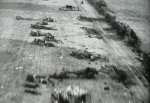
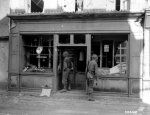
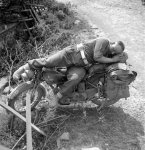
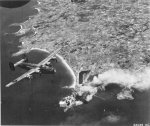
Bradley, over-cautious, had incorrectly assumed that most of the the Germans had already escaped, and feared a German counterattack against overextended Americans. Bradley later admitted a mistake had been made, but blamed his superior Montgomery (as did Eisenhower), for moving the Canadians too slowly. Bradley has underestimated the effectiveness of the Allied air forces in stopping all German movements during the daytime, thus making a counterattack highly risky for them. This mistake eventually allows about 40,000 German troops to escape through the gap, avoiding encirclement and almost certain destruction. At the end of the day, more than 10,000 German soldiers belonging to the 12th SS Panzer Division have escaped the pocket and head towards the Seine river.
Above France, RAF Bomber Command sends 29 aircraft to attack Brest and 15 aircraft to attack Bordeaux during the day. US 8th Air Force conducts attacks with 1,200 bombers in an effort to interdict German withdrawal from Normandy. US 8th Air Force also conducts 844 fighter sorties against transportation lines and motor vehicles. US 9th Air Force attacks transportation lines, bridges, and vehicle traffic around Falaise pocket. In the first operational use of unmanned B-17 (as part of Operation Aphrodite), the bomber misses its intended target at Le Havre.
On the eastern front, Soviet 3rd Baltic Front captures Verro and Valk.
In Poland, Germans deploy a 600mm mortar, two 380mm howitzers, and two 280mm howitzers against Polish Home Army in Warsaw. Allied Balkan Air Force sends 28 Polish, British, and South African bombers from Italian bases to drop supplies to Home Army in Warsaw overnight, with two aircraft lost.
In Italy, elements of British 8th Army cross the Ponte Vecchio into northern Florence. US 12th Air Force aircraft attack targets along the Arno River and in northern Italy. Kriegsmarine minelayer Dietrich von Bern sunk by Allied air attack at Genoa.
Pictured: A Hawker Typhoon fighter bomber flying over a destroyed German column attempting to escape the Falaise pocket; Two US soldiers take a look at the damage of a store in Rue de Lassay, Couterne. The town was liberated at August 13, 1944 between 9:00 PM and midnight by the 1 st US ID; Lance Corporal Bill Baggott sleeps on his motorcycle in Falaise, France, August 13, 1944 ; B-24J Liberators of the 565th Bomb Squadron bomb targets in St Malo, France, August 13, 1944. The aircraft seen here was destroyed the next day when it crash landed and burned at RAF Hethel, Norfolk




Last edited:
I have never heard an estimate as high as 240K escapees from the pocket...August 13, 1944: The situation for the Germans in Normandy is now borderline catastrophic - dozens of divisions are almost completely encircled by the Allies in the Falaise pocket. The Americans attack south of the pocket along three axes: to the east, the XIX Corps of the 1st Army assaults four divisions (including one armored), on its right flank, the VII Corps of the 1st Army, the French 2nd Armored Division and the American XV Corps progress to close the trap. After Bradley unexpectedly halted the advance of Patton's XV Corps yesterday - stopping just 25 miles south of the Canadian forces to the north - the Allies fail to close the Argentan-Falaise pocket containing the almost-surrounded German forces. The Germans of the 7th Army, led by General Hausser, begin to evacuate a maximum number of divisions outside the pocket, and large units such as SS Panzer divisions take priority (especially the tanks). The Allied air forces tirelessly bomb the pocket, almost like a ‘training ground’ for fighter-bombers pilots who have an impressive number of retreating targets.
Bradley, over-cautious, had incorrectly assumed that most of the the Germans had already escaped, and feared a German counterattack against overextended Americans. Bradley later admitted a mistake had been made, but blamed his superior Montgomery (as did Eisenhower), for moving the Canadians too slowly. Bradley has underestimated the effectiveness of the Allied air forces in stopping all German movements during the daytime, thus making a counterattack highly risky for them. This mistake eventually allows about 240,000 German troops (and 30,000 vehicles) escape through the gap, avoiding encirclement and almost certain destruction. At the end of the day, more than 10,000 German soldiers belonging to the 12th SS Panzer Division have escaped the pocket and head towards the Seine river.
Above France, RAF Bomber Command sends 29 aircraft to attack Brest and 15 aircraft to attack Bordeaux during the day. US 8th Air Force conducts attacks with 1,200 bombers in an effort to interdict German withdrawal from Normandy. US 8th Air Force also conducts 844 fighter sorties against transportation lines and motor vehicles. US 9th Air Force attacks transportation lines, bridges, and vehicle traffic around Falaise pocket. In the first operational use of unmanned B-17 (as part of Operation Aphrodite), the bomber misses its intended target at Le Havre.
On the eastern front, Soviet 3rd Baltic Front captures Verro and Valk.
In Poland, Germans deploy a 600mm mortar, two 380mm howitzers, and two 280mm howitzers against Polish Home Army in Warsaw. Allied Balkan Air Force sends 28 Polish, British, and South African bombers from Italian bases to drop supplies to Home Army in Warsaw overnight, with two aircraft lost.
In Italy, elements of British 8th Army cross the Ponte Vecchio into northern Florence. US 12th Air Force aircraft attack targets along the Arno River and in northern Italy. Kriegsmarine minelayer Dietrich von Bern sunk by Allied air attack at Genoa.
Pictured: A Hawker Typhoon fighter bomber flying over a destroyed German column attempting to escape the Falaise pocket; Two US soldiers take a look at the damage of a store in Rue de Lassay, Couterne. The town was liberated at August 13, 1944 between 9:00 PM and midnight by the 1 st US ID; Lance Corporal Bill Baggott sleeps on his motorcycle in Falaise, France, August 13, 1944 ; B-24J Liberators of the 565th Bomb Squadron bomb targets in St Malo, France, August 13, 1944. The aircraft seen here was destroyed the next day when it crash landed and burned at RAF Hethel, Norfolk
View attachment 4121
View attachment 4122
View attachment 4123
View attachment 4124
Just looking casually, I see estimates of 20-50K escapees. 240K is mind-boggling...I have never heard an estimate as high as 240K escapees from the pocket...
Perhaps the number is a typo?I have never heard an estimate as high as 240K escapees from the pocket...
https://www.warhistoryonline.com/war-articles/code-talker-marine-passes-away.html
On the other hand, 20-50,000 Germans had escaped from the pocket while the Allies struggled to close the gap. Many historians have criticized the generals for not completing the encirclement sooner.
August 13, 1944: The situation for the Germans in Normandy is now borderline catastrophic - dozens of divisions are almost completely encircled by the Allies in the Falaise pocket. The Americans attack south of the pocket along three axes: to the east, the XIX Corps of the 1st Army assaults four divisions (including one armored), on its right flank, the VII Corps of the 1st Army, the French 2nd Armored Division and the American XV Corps progress to close the trap. After Bradley unexpectedly halted the advance of Patton's XV Corps yesterday - stopping just 25 miles south of the Canadian forces to the north - the Allies fail to close the Argentan-Falaise pocket containing the almost-surrounded German forces. The Germans of the 7th Army, led by General Hausser, begin to evacuate a maximum number of divisions outside the pocket, and large units such as SS Panzer divisions take priority (especially the tanks). The Allied air forces tirelessly bomb the pocket, almost like a ‘training ground’ for fighter-bombers pilots who have an impressive number of retreating targets.
Bradley, over-cautious, had incorrectly assumed that most of the the Germans had already escaped, and feared a German counterattack against overextended Americans. Bradley later admitted a mistake had been made, but blamed his superior Montgomery (as did Eisenhower), for moving the Canadians too slowly. Bradley has underestimated the effectiveness of the Allied air forces in stopping all German movements during the daytime, thus making a counterattack highly risky for them. This mistake eventually allows about 240,000 German troops (and 30,000 vehicles) escape through the gap, avoiding encirclement and almost certain destruction. At the end of the day, more than 10,000 German soldiers belonging to the 12th SS Panzer Division have escaped the pocket and head towards the Seine river.
Above France, RAF Bomber Command sends 29 aircraft to attack Brest and 15 aircraft to attack Bordeaux during the day. US 8th Air Force conducts attacks with 1,200 bombers in an effort to interdict German withdrawal from Normandy. US 8th Air Force also conducts 844 fighter sorties against transportation lines and motor vehicles. US 9th Air Force attacks transportation lines, bridges, and vehicle traffic around Falaise pocket. In the first operational use of unmanned B-17 (as part of Operation Aphrodite), the bomber misses its intended target at Le Havre.
On the eastern front, Soviet 3rd Baltic Front captures Verro and Valk.
In Poland, Germans deploy a 600mm mortar, two 380mm howitzers, and two 280mm howitzers against Polish Home Army in Warsaw. Allied Balkan Air Force sends 28 Polish, British, and South African bombers from Italian bases to drop supplies to Home Army in Warsaw overnight, with two aircraft lost.
In Italy, elements of British 8th Army cross the Ponte Vecchio into northern Florence. US 12th Air Force aircraft attack targets along the Arno River and in northern Italy. Kriegsmarine minelayer Dietrich von Bern sunk by Allied air attack at Genoa.
Pictured: A Hawker Typhoon fighter bomber flying over a destroyed German column attempting to escape the Falaise pocket; Two US soldiers take a look at the damage of a store in Rue de Lassay, Couterne. The town was liberated at August 13, 1944 between 9:00 PM and midnight by the 1 st US ID; Lance Corporal Bill Baggott sleeps on his motorcycle in Falaise, France, August 13, 1944 ; B-24J Liberators of the 565th Bomb Squadron bomb targets in St Malo, France, August 13, 1944. The aircraft seen here was destroyed the next day when it crash landed and burned at RAF Hethel, Norfolk
View attachment 4121
View attachment 4122
View attachment 4123
View attachment 4124
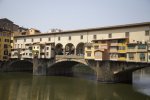
Ponte Vecchio the bridge over the river Arno was mentioned earlier as one of the bridges in Florence that was not bombed and is now a crossing for the Americans over the Arno in the campaign in the Rome area. The bridge dating to Medieval Italy was referred to in the famous aria by Giacomo Puccini, O Mia Babbino Caro
andrei sul Ponte Vecchio, ma perbuttarmi in Arno!
I'd go to the *Ponte Vecchio*,
to fling myself into the *Arno*!
I think so. I don't think they had 240K in the 7th army and other units, total, by then...Perhaps the number is a typo?
https://www.warhistoryonline.com/war-articles/code-talker-marine-passes-away.html
Aye, I mistyped it initially and never caught it - thanks, Earle!Perhaps the number is a typo?
The number was supposed to be 40,000 - fixed...
Here is a sample. From Martin Blumenson, Breakout and Pursuit, p. 516.I think so. I don't think they had 240K in the 7th army and other units, total, by then...
Source: Mittagmeldung, 15 Aug, OB WEST KTB (Kriegstagebuch), Anlagen, p. 1403.Panzer Group Eberbach was also drastically reduced in strength by 13 August. The 9th Panzer Division had only 260 men, 12 tanks, and a few artillery pieces. The 1st SS Panzer Division had 352 men, 8 self-propelled assault guns, and 14 Mark IV and 7 Mark V tanks. The 2d Panzer Division, which had had 2,220 men, 5 self-propelled assault guns, and 9 Mark IV and 3 Mark V tanks on 11 [August], was considerably diminished two days later.
A full-strength division is supposed to have 10,000-15,000 men. The fact that 9th Panzer Division had 260 give an idea of the intensity of the combat and the seriousness of the losses. The Germans got hammered in August 1944.
Last edited:
That was about in the middle of the 20K-50K I've always read. As TW points out, they didn't even begin to have that many troops still in the field. I believe their captured total would have exceeded 100K at that time, excluding killed and wounded past the point of evacuation. Hitler and his misguided tactics in Normandy hastened the end of the war. He was soon left to fighting both fronts with old men and children...Aye, I mistyped it initially and never caught it - thanks, Earle!
The number was supposed to be 40,000 - fixed...
The figure for the Hitlerjugend division sounds high.August 13, 1944: ... At the end of the day, more than 10,000 German soldiers belonging to the 12th SS Panzer Division have escaped the pocket and head towards the Seine river.
5th Panzer Army commander was "Sepp" Dietrich. He was not especially competent, but he was an SS officer and a loyal Nazi, so Hitler liked him and gave him command of the 5th Panzer Army.
Martin Blumenson, Breakout and Pursuit, 577, citing "Telecon, Rotbers and Tempelhoff, 1545, 21 Aug, and Fifth Pz Army Rpt, 0650, 28 Aug, AGp B KTB."Dietrich on 21 August instructed two corps of his army to count their men, tanks, and artillery pieces. The count was discouraging. The I SS Panzer Corps reported that the 10th SS Panzer Division had only a weak infantry battalion (perhaps 300 men), no tanks, no guns; the 12th SS Panzer Division had 300 men, 10 tanks, no artillery; the 1st SS Panzer Division was unable to give any figures. The II SS Panzer Corps reported that the 2d SS Panzer Division had 450 men, 15 tanks, 6 guns; the 9th SS Panzer Division had 460 men, 20 to 25 tanks, and 20 guns; the 116th Panzer Division had one battalion of infantry (perhaps 500 or 600 men), 12 tanks, and no artillery. A week later the strength of these divisions, plus that of the 21st Panzer Division--all that remained of Model's armored forces--totaled 1,300 men, 24 tanks, and 60 artillery pieces."
I know I'm getting a head of the narrative, but this showed how bad things got for the Germans, even with Bradley halting Patton's guys.
LOL! A corporal puts his chauffeur in charge of an army...The figure for the Hitlerjugend division sounds high.
5th Panzer Army commander was "Sepp" Dietrich. He was not especially competent, but he was an SS officer and a loyal Nazi, so Hitler liked him and gave him command of the 5th Panzer Army.
Martin Blumenson, Breakout and Pursuit, 577, citing "Telecon, Rotbers and Tempelhoff, 1545, 21 Aug, and Fifth Pz Army Rpt, 0650, 28 Aug, AGp B KTB."
I know I'm getting a head of the narrative, but this showed how bad things got for the Germans, even with Bradley halting Patton's guys.
What's funny is that Dietrich was given command of the 6th SS Panzer Army for the Battle of the Bulge and the 6th performed worse than the 5th Panzer Army in the Bulge. The 6th Panzer Army's performance was quite poor (and the committed atrocities to boot).LOL! A corporal puts his chauffeur in charge of an army...
What'd he get for the Malmedy massacre? Something less than two years? He was a Nazi stooge, pure and simple. His sole redeeming virtue was following orders to go kill Röhm and other SA. So, Hitler makes him a general...What's funny is that Dietrich was given command of the 6th SS Panzer Army for the Battle of the Bulge and the 6th performed worse than the 5th Panzer Army in the Bulge. The 6th Panzer Army's performance was quite poor (and the committed atrocities to boot).
August 14, 1944: The closing of the Falaise pocket is finally ordered. To accomplish this, the Canadians start Operation Tractable (the final offensive conducted by Canadian and Polish Army troops as part of the Battle of Normandy), which aims to control the main exits of the Germans by capturing the strategically important town of Falaise, and following that, the smaller towns of Trun and Chambois. The Allied air force sends 800 Avro Lancaster and Handley Page Halifax heavy bombers to the north and south of Falaise, but as with Totalize, many of the bombers mistakenly dropped their bombs short of their targets, causing 400 Polish and Canadian casualties. After the bombings ceased, three Canadian divisions (2nd and 3rd Infantry, 4th Armored Division), the Polish 1st Armored Division, and the British 53rd Infantry Division start the offensive. Throughout the day, continual attacks by the Canadian 4th and Polish 1st Armored Divisions manage to force a crossing of the Laison River. The 1st, 12th and 21st SS Panzer divisions start to counter-attack northwest toward Soulangy, but the Allies stop these attacks while the Polish 1st Armored Division progresses to the east of Falaise in order to cut off the retreat of the German divisions. The German officers continue to receive Hitler's orders prohibiting any retreat to the east, ordering the officers instead to stay where they are.
Meanwhile, the US 15th Corps (part of US 3rd Army) begins to advance eastward from Argentan toward Dreux. Elements of US 1st Army move into position at Argentan. In Brittany, forces of US 3rd Army clear German resistance from most of St. Malo except for the ancient citadel in the port area.
Over France, RAF Bomber Command sends 805 aircraft to attack German troop positions around Falaise and 159 aircraft to attack Brest during the day. US 8th Air Force attacks Metz with 72 bombers, ttacks airfields, bridges, and rail lines with 354 bombers escorted by 92 fighters, and attacks targets around Paris with 136 fighters. US 9th Air Force attacks transportation lines, bridges, and vehicle traffic around Falaise pocket.
On the eastern front, the German 3rd Panzer Army counterattacks the 51st Army of Soviet 1st Baltic Front around Jelgava-Riga. Troops of 47th Army of Soviet 1st Belorussian Front attack north of Warsaw, and German IV SS Panzer Korps counterattacks. 2nd Tank Army of Soviet 1st Belorussian Front attacks south of Warsaw.
In Italy, US 12th Air Force aircraft attack targets along the Arno River and in northern Italy and US 15th Air Force attacks Genoa.
Pictured: American soldiers welcomed by French citizens, August 14, 1944; Infantry soldiers and US armored vehicles of the 41st Armored Infantry Regiment, 2nd Armored Division come down the Rue Saint Michel in the village of Lonlay l’abbaye, Normandy, August 14, 1944; A Canadian medic is rescuing a buddy near a burning Sturmgeschütz III, just north of Falaise, August 14, 1944; Polish insurgent fighters with captured German SdKfz. 251 halftrack vehicle, Warsaw, Poland, August 14, 1944
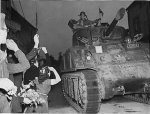
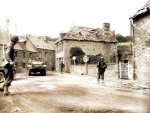
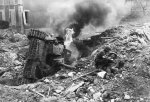

Meanwhile, the US 15th Corps (part of US 3rd Army) begins to advance eastward from Argentan toward Dreux. Elements of US 1st Army move into position at Argentan. In Brittany, forces of US 3rd Army clear German resistance from most of St. Malo except for the ancient citadel in the port area.
Over France, RAF Bomber Command sends 805 aircraft to attack German troop positions around Falaise and 159 aircraft to attack Brest during the day. US 8th Air Force attacks Metz with 72 bombers, ttacks airfields, bridges, and rail lines with 354 bombers escorted by 92 fighters, and attacks targets around Paris with 136 fighters. US 9th Air Force attacks transportation lines, bridges, and vehicle traffic around Falaise pocket.
On the eastern front, the German 3rd Panzer Army counterattacks the 51st Army of Soviet 1st Baltic Front around Jelgava-Riga. Troops of 47th Army of Soviet 1st Belorussian Front attack north of Warsaw, and German IV SS Panzer Korps counterattacks. 2nd Tank Army of Soviet 1st Belorussian Front attacks south of Warsaw.
In Italy, US 12th Air Force aircraft attack targets along the Arno River and in northern Italy and US 15th Air Force attacks Genoa.
Pictured: American soldiers welcomed by French citizens, August 14, 1944; Infantry soldiers and US armored vehicles of the 41st Armored Infantry Regiment, 2nd Armored Division come down the Rue Saint Michel in the village of Lonlay l’abbaye, Normandy, August 14, 1944; A Canadian medic is rescuing a buddy near a burning Sturmgeschütz III, just north of Falaise, August 14, 1944; Polish insurgent fighters with captured German SdKfz. 251 halftrack vehicle, Warsaw, Poland, August 14, 1944




- Status
- Not open for further replies.
Latest threads
-
No. 1 Visits Tuscaloosa for Second Straight Week as Alabama Hosts Top-Ranked Texas A&M
- Started by Diamond Tide
- Replies: 0
-
-
I'm Declaring the Emporer has no clothes (NCAA rules implosion)
- Started by BamaNation
- Replies: 14
-
Home-and-Home Series Wraps Up as Alabama Welcomes UAB on Tuesday
- Started by Diamond Tide
- Replies: 1
-
-
A huge win today at my doctor's office...
- Started by uafan4life
- Replies: 4

